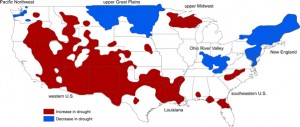Darren Ficklin at Indiana University has a new paper exploring trends in drought in the United States which notes that the trends are not universal:
[F]our regions of increasing (upper Midwest, Louisiana, southeastern United States (US), and western US) and decreasing (New England, Pacific Northwest, upper Great Plains, and Ohio River Valley) drought trends….

By one measure, increasing drought in the west. From A climatic deconstruction of recent drought trends in the United States,Darren L Ficklin et al 2015 Environ. Res. Lett. 10 044009
doi:10.1088/1748-9326/10/4/044009
But we need a more fine-grained analysis, Ficklin and colleagues acknowledge, in order to be careful in what we mean by “drought”:
While the general definition of drought—a deficit of precipitation—is well known, quantifying drought is more difficult. The challenges result from the diversity of questions one can ask about drought leading to differences in the classification of drought over varying timespans, and the influence of drought on a variety of socioeconomic factors.
Jim Dalrymple has a terrific piece in BuzzFeed today that takes this insight and runs with it:
You may have heard that the current drought is California’s worst in 1,200 years. That oft-cited figure comes from a paper by Daniel Griffin, of the University of Minnesota, and Kevin Anchukaitis, of the Woods Hole Oceanic Institution.
In conversations with BuzzFeed News, both researchers explained that they came to that conclusion after studying tree ring samples, as well as using what’s known as the Palmer Drought Severity Index, or PDSI. Basically the PDSI measures soil moisture as it compares to what is “normal” for a particular place.
What Anchukaitis and Griffin ultimately found is that the soil moisture in central and southern California has fallen to it’s lowest level for any three year period on record. Other droughts may have been longer or drier, but they were punctuated by rainy years.
But that isn’t the end of the story. Griffin and Anchukaitis were looking only at one type of data, and both said there are other ways to evaluate the drought.
“There’s no one definition of drought,” Anchukaitis explained.
Both Ficklin and Darlymple are worth your clicks.
And an additional recommendation: if you’re on the Twitter, I suggest you follow Kevin Anchukaitis, the Woods Hole climate scientist who is quoted in Dalrymple’s story, and whose tweets brought both of these to my attention.

Not my area of forte, but I think that it makes sense that the definition of “drought” would be different for each area/climate. It sounds silly (to me) to talk about “decreasing drought.” I think of drought as being binary, though it has degrees of severity, so how can you be in a “decreasing drought trend” if you weren’t in a drought in the first place.
Ed – Yeah, the words get really tangled when you start talking about “undrought”, whatever that is. “Pluvial”? I think the word is more trouble than it’s worth, but language happens through use, so we’re stuck with the word and have make the best of it.